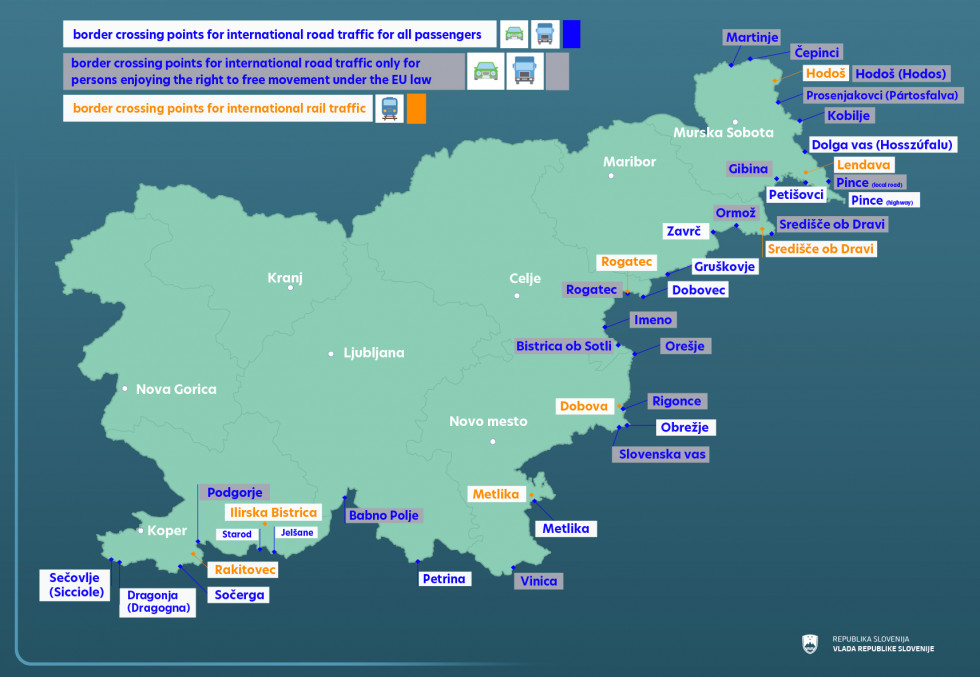Temporary control on the internal border
Border control was reintroduced due to the increased terrorist threat in order to ensure high level of security for all the residents. Border checks will remain in force until 21 December 2025.
Slovenian national authorities have been noting a growing scale of organised crime in the Western Balkans. Similarly, Slovenian law enforcement authorities have been closely following potential threats and the security situation in Slovenia and the region, along with the factors that could cause an increase in radicalisation of individuals and violent extremism.
Information for travellers
In order to cross the border, tarvellers are required to present a valid travel document. They should therefore check the validity of their travel documents beforehand.
Travellers should observe the conditions for crossing the border at specific border crossing points, follow a changed traffic regime and instructions of police officers.
Crossing the border with Croatia
The crossing of the internal land border with Croatia is allowed at the following 12 border crossing points for international road traffic (passengers and cargo transport):
- Sečovlje (Sicciole) – checkpoint,
- Dragonja (Dragogna),
- Sočerga,
- Starod,
- Jelšane,
- Petrina,
- Metlika,
- Obrežje,
- Dobovec,
- Gruškovje,
- Zavrč, and
- Petišovci.
The crossing of the internal land border with Croatia is also possible at the following 7 border crossing points for international rail traffic:
- Rakitovec,
- Ilirska Bistrica,
- Metlika,
- Dobova,
- Rogatec,
- Središče ob Dravi, and
- Lendava.
The persons enjoying the right to free movement under the EU law can cross the internal land border with Croatia at the following 12 border crossing points for international road traffic (passengers and cargo transport):
- Podgorje,
- Babno polje,
- Vinica,
- Slovenska vas,
- Rigonce,
- Orešje,
- Bistrica ob Sotli,
- Imeno,
- Rogatec,
- Ormož,
- Središče ob Dravi, and
- Gibina.
The persons who enjoy the right to freedom of movement under the EU law are citizens of the European Union and nationals of Norway, Iceland, Liechtenstein and Switzerland, and their family members, regardless of their nationality. The same right also applies to third-country nationals and their family members, regardless of their nationality, who, pursuant to agreements between the EU and its member states and relevant third countries, have a right to free movement equivalent to that enjoyed by EU citizens.
Crossing the border with Hungary
Travellers are allowed to cross the internal land border with Hungary at the following border crossing points for international road traffic (passengers and cargo transport):
- Dolga vas – Hosszúfalu, and
- Pince (motorway) – Pince.
The crossing of the internal land border with Hungary is also possible at the following border crossing point for international rail traffic:
- Hodoš - Hodos.
The persons enjoying the right to free movement under the EU law can cross the internal land border with Hungary at the following 6 border crossing points for international road traffic (passengers and cargo transport):
- Pince (local road) – Pince,
- Prosenjakovci – Pártosfalva,
- Hodoš – Hodos,
- Kobilje,
- Čepinci, and
- Martinje.
The persons who enjoy the right to freedom of movement under the EU law are citizens of the European Union and nationals of Norway, Iceland, Liechtenstein and Switzerland, and their family members, regardless of their nationality. The same right also applies to third-country nationals and their family members, regardless of their nationality, who, pursuant to agreements between the EU and its member states and relevant third countries, have a right to free movement equivalent to that enjoyed by EU citizens.
Crossing the border with Italy
Italy decided to introduce the control of our shared state border due to the changed security situation in Europe and the Middle East for the period between 21 October 2023 and 18 December 2025.
In this period, entry and exit from Italy is allowed to all EU and third country nationals on all border crossings.
Crossing the border with Austria
Austria controls the state border with Slovenia. The border can be crossed on all border crossings with a valid travel document.


